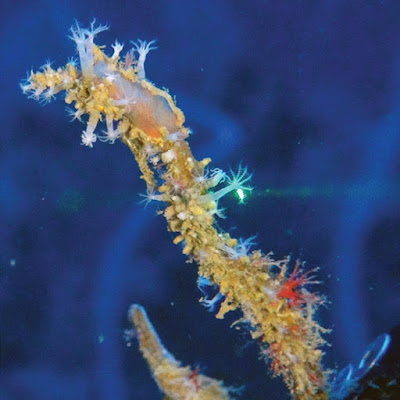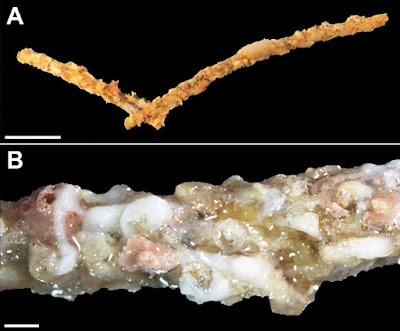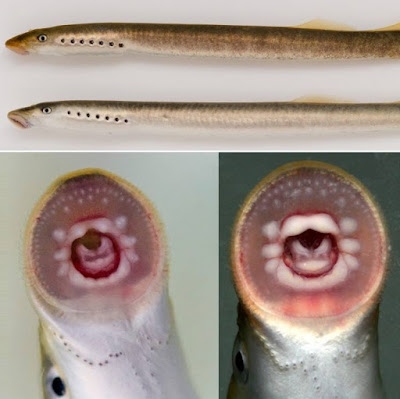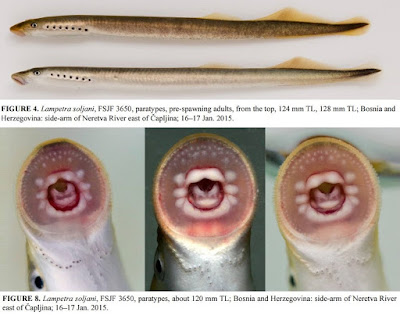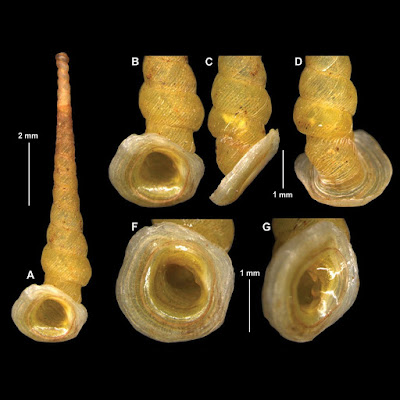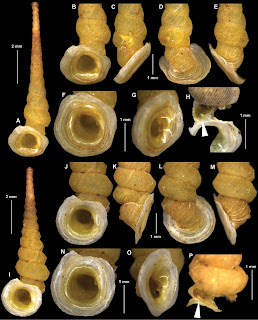[Most Recent Entries] [Calendar View]
Sunday, June 18th, 2017
| Time | Event | ||||||
| 12:46p | [Cnidaria • 2017] Altumia delicata • A New Sclerite-Free Genus from Eilat, northern Red Sea [Search for Mesophotic Octocorals (Cnidaria, Anthozoa) and Their Phylogeny]
Abstract This communication describes a new octocoral, Altumia delicata gen. n. & sp. n. (Octocorallia: Clavulariidae), from mesophotic reefs of Eilat (northern Gulf of Aqaba, Red Sea). This species lives on dead antipatharian colonies and on artificial substrates. It has been recorded from deeper than 60 m down to 140 m and is thus considered to be a lower mesophotic octocoral. It has no sclerites and features no symbiotic zooxanthellae. The new genus is compared to other known sclerite-free octocorals. Molecular phylogenetic analyses place it in a clade with members of families Clavulariidae and Acanthoaxiidae, and for now we assign it to the former, based on colony morphology. The polyphyletic family Clavulariidae is, however, in need of a thorough revision once the morphological distinctions among its phylogenetically distinct clades are better understood. Keywords: Octocorallia, new genus, taxonomy, mesophotic coral ecosystem, Eilat, Red Sea Family Clavulariidae Hickson, 1894 Subfamily Clavulariinae Roxas, 1933 Altumia gen. n. Diagnosis: Clavulariinae with a thin and soft encrusting base, sometimes resembling a short stolon. Polyps erect when expanded, separate from each other; the stolon may feature a few polyps, occasionally only one. Polyps fully retractile into base of the colony, forming low truncated dome-shaped mounds. No sclerites in any part of the colony. Colonies lack symbiotic algae (zooxanthellae). Type species: Altumia delicata sp. n. by original designation and monotypy. Etymology: The generic name is derived from the Latin ‘altum’, deep, referring to the habitat of the new genus at MCE depths and beyond. Gender female.
Altumia delicata sp. n. Holotype: ZMTAU CO 37427, Israel, Gulf of Aqaba, Eilat, 29°30'38.31"N, 34°55'59.30"E, 132 m, 30 May 2016, collected by ROV, coll. M. Weis; paratype: ZMTAU CO 37495, Israel, Gulf of Aqaba, Eilat, 29°30'37.29"N, 34°55'59.28"E, 118 m, 8 March 2017, collected by ROV, coll. M. Weis Diagnosis: The ethanol-preserved holotype is comprised of thin patches of short stolon-like crusts growing over the dead branch of a black coral (Antipatharia) (Figure 2A), almost invisible to the naked eye. The milky-white, thin (<0.5 mm) crusts are a few mm long (Figure 2B), very soft, almost slime-like. Polyps completely retracted and practically invisible in the preserved colonies. No sclerites observed in any part of the colony. Intraspecific variability: There are no differences between the holotype and the paratype except for the size of the colonies. Etymology: The species name is formed from the Latin ‘delicata’, delicate, referring to the fine texture of the colonies and their polyps. Gender female.
Yehuda Benayahu, Catherine S. McFadden and Erez Shoham. 2017. Search for Mesophotic Octocorals (Cnidaria, Anthozoa) and Their Phylogeny: I. A New Sclerite-Free Genus from Eilat, northern Red Sea. ZooKeys. 680: 1-11. DOI: 10.3897/zookeys.680.12727 | ||||||
| 12:55p | [Ichthyology • 2017] Lampetra soljani • A New Brook Lamprey (Petromyzontiformes: Petromyzontidae) from the southern Adriatic Sea Basin Abstract Lampetra soljani, new species, is described from the lower Neretva River in the Adriatic Sea basin. Previously it was identified as L. zanandreai. Based on morphological similarity and mitochondrial genetic data, it is related to L. lanceolata and L. ninae from the Black Sea basin. Lampetra soljani is distinguished from all other species of Lampetra by having a marmorate flank pattern in live, fully grown ammocoetes, and in some adults (vs. plain colour pattern). Lampetra soljani is distinguished from other Lampetra species by having three velar tentacles, 54–57 trunk myomeres between the last branchial opening and the anus, no posterial teeth and a bicuspid middle endolateral tooth. Lampetra soljani is also well distinguished by COI barcode data from its congeners. The new species is widespread in the Neretva River drainage and lampreys from Lake Skadar basin are likely to belong to this species also. Keywords: Pisces, Freshwater biodiversity, Mediterranean basin, Dinaric Biodiversity Hotspot Etymology. Named in honour of Tonko Šoljan (1907–1980) in appreciation of his contribution to the knowledge and development of ichthyology in Croatia and Bosnia and Herzegovina. Pero Tutman, Jörg Freyhof, Jakov Dulčić, Branko Glamuzina and Matthias Geiger. 2017. Lampetra soljani, A New Brook Lamprey from the southern Adriatic Sea basin (Petromyzontiformes: Petromyzontidae). Zootaxa. 4273(4); 531–548. DOI: 10.11646/zootaxa.4273.4.4 | ||||||
| 1:19p | [Gastropoda • 2017] Luzonocoptis antenna & L. angulata • A New Diplommatinid Genus and Two New Species (Caenogastropoda, Cyclophoroidea) from the Philippines
Abstract A new diplommatinid genus, Luzonocoptis Páll-Gergely & Hunyadi, gen. n. is erected for two new species, Luzonocoptis antenna Páll-Gergely & Hunyadi, sp. n. and L. angulata Páll-Gergely & Hunyadi, sp. n. Both species inhabit the northeastern part of Luzon Island, Philippines. The genus Luzonocoptis gen. n. is mostly characterized by a very slender shell with 14–18 whorls, a strongly expanded peristome, an interrupted, weak columellar lamella, the absence of any additional plicae or lamellae, and a rachidian tooth having five cusps. Keywords: Land snail, Luzon, rock habitat, systematics, taxonomy Diplommatinidae Pfeiffer, 1856 Genus Luzonocoptis Páll-Gergely & Hunyadi, gen. n. Diagnosis: Shell sinistral; apex blunt, club-like; shell very slender with 14–18 whorls, rather regularly, finely ribbed; aperture round with a weak columellar lamella visible from standard apertural view; columellar lamella interrupted, its inner, short portion blunt thorn or tubercle-like, situated inside post-constriction bay; other inner plicae and lamellae absent; outer surface of operculum matt, smooth; inner surface with a very slightly elevated arcuate ridge; rachidian tooth with five cusps (central one blunt, larger than other four cusps), marginal teeth with four pointed cusps. Differential diagnosis: Luzonocoptis gen. n. differs from Palaina Semper, 1865 (type species: Diplommatina macgillivrayi Pfeiffer, 1854) by the unique shell shape, the strongly expanded peristome, and most importantly, the presence of a columellar tooth, which continues to a strongly developed lamella (see Yamazaki et al. 2013 and Neubert and Bouchet 2013). The most similar diplommatinid genus in terms of shell characters is Hungerfordia. Luzonocoptis gen. n. differs from Hungerfordia by the presence of an interrupted columellar lamella, and the rachidian tooth, which possess five well-developed cusps. In contrast, the columellar lamella of Hungerfordia is not interrupted, and the rachidian tooth is simpler, with a single, or three cusps. Etymology: The first part of the name derives from the name of the island (Luzon), where the included new species have been found. The second part (“-coptis”) refers to the similarity with Middle American urocoptid taxa in terms of shell size, shape, colour and habitat. Gender feminine. Type species: Luzonocoptis antenna sp. n. Content: Luzonocoptis antenna sp. n. and L. angulata sp. n. Distribution: This genus is known so far from northeastern Luzon Island. The distance between the type localities of the two species is approximately 34 km in a straight line. Luzonocoptis antenna Páll-Gergely & Hunyadi, sp. n. Diagnosis: A tall, yellowish, very slender diplommatinid with club-shaped apex, dense, low ribs on the last whorl, rounded lower whorls, strongly expanded and reflected peristome that is strongly oblique to the shell axis, and a weak interrupted columellar lamella. Etymology: The shell shape of this new species (wide aperture, very slender upper whorls, and a club-shaped apex) resembles a radio antenna. The specific epithet antenna to be used as a noun in apposition. Habitat and distribution: Living specimens were found on a limestone rock wall. This species is known from the type locality only, which is situated ca. 34 km in a straight line from the type locality of L. angulata sp. n. Luzonocoptis angulata Páll-Gergely & Hunyadi, sp. n. Diagnosis: A tall, yellowish, moderately slender diplommatinid with club-shaped apex, widely spaced, sharp ribs on the last whorl, angled lower whorls, strongly expanded peristome that is slightly oblique to the shell axis, and a weak interrupted columellar lamella. Etymology: The specific epithet angulata (Latin: angled) refers to the keeled lower whorls, which distinguishes this species from L. antenna sp. n. Habitat and distribution: Empty shells were found at the base of a limestone rock wall. This species is known from the type locality only, which is situated ca. 34 km in a straight line from the type locality of L. antenna sp. n. Barna Páll-Gergely, András Hunyadi and Takahiro Asami. 2017. A New Diplommatinid Genus and Two New Species from the Philippines (Gastropoda, Caenogastropoda, Cyclophoroidea). ZooKeys. 678; 1-10. DOI: 10.3897/zookeys.678.13059 |
| << Previous Day |
2017/06/18 [Calendar] |
Next Day >> |
